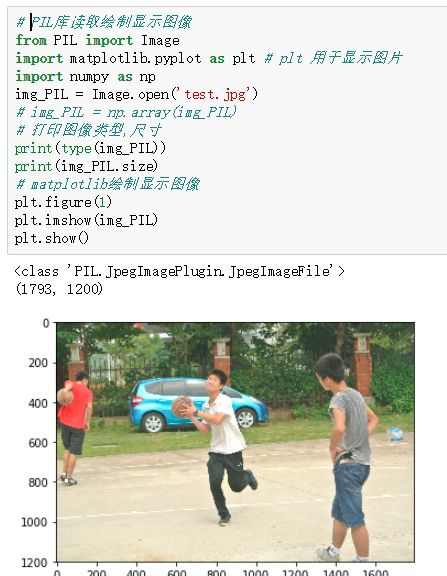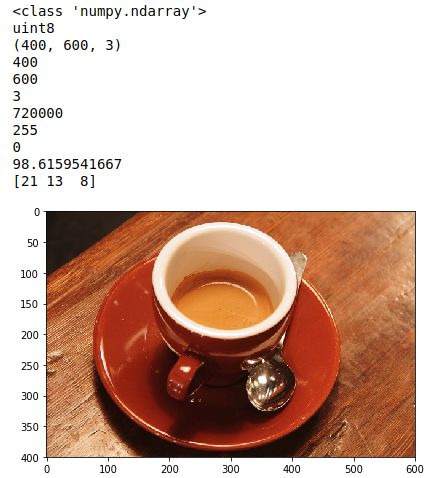Python 读取图像方式总结
- 读取并显示图像
- opencv3库
- scikit-image库
- PIL库
- 读取图像结果分析
- 打印图像信息
- skimage获取图像信息
- PIL获取图像信息
- 读取并显示图像方法总结
- PIL库读取图像
- Opencv3读取图像
- scikit-image库读取图像
- 参考资料
学习数字图像处理,第一步就是读取图像。这里我总结下如何使用 opencv3,scikit-image, PIL 图像处理库读取图片并显示。
读取并显示图像
opencv3库
opencv 读取图像,返回的是矩阵数据,RGB 图像的 shape 是 (height, weight, channel),dtype 是 uint8。
示例代码如下:
import cv2
# 读入一副彩色图像
img_cv2 = cv2.imread('test.jpg',cv2.IMREAD_COLOR)
# 打印图像尺寸,形状,图像元素数据类型
print(type(img_cv2))
print(img_cv2.shape) # (height, width, channel)
print(img_cv2.dtype) # uint8
# matplotlib绘制显示图像
plt.figure(1)
plt.imshow(img_PIL)
plt.show()
# cv2绘制显示图像
# cv2.imshow()
# cv2.namedWindow('image', cv2.WINDOW_NORMAL)
# cv2.imshow('image',img_cv2)
# cv2.waitKey(0)
# cv2.destroyAllWindows()
scikit-image库
示例代码如下:
from skimage import io
img_skimage = io.imread('test.jpg')
# 打印图像尺寸
print(img_skimage.shape) #(height, width, channel)
# 绘制显示图像
io.imshow(img_skimage)
# import matplotlib.pyplot as plt
# plt.imshow(img_skimage)
注意:io.imshow(img_skimage),这一行代码的实质是利用matplotlib包对图片进行绘制,绘制成功后,返回一个matplotlib类型的数据。也就是说scikit-image库对图像的绘制实际上是调用了matplotlib库imshow显示函数。
cv2和skimage读取图像,图像的尺寸可以通过其shape属性来获取,shape返回的是一个tuple元组,第一个元素表示图像的高度,第二个表示图像的宽度,第三个表示像素的通道数。
PIL库
示例代码如下:
# PIL库读取绘制显示图像
# plt 用于显示图片
from PIL import Image
import matplotlib.pyplot as plt
import numpy as np
img_PIL = Image.open('test.jpg')
img_PIL = np.array(img_PIL)
# 打印图像类型,尺寸和总像素个数
print(type(img_PIL)) # 读取图像结果分析
分别用Opnecv3和sckit-image读取图像,并用matplotlib库显示。示例代码如下:
import cv2
from skimage import io
import matplotlib.pyplot as plt
img_cv2 = cv2.imread('test.jpg',cv2.IMREAD_COLOR)
img_skimage = io.imread('test.jpg')
# matplotlib显示cv2库读取的图像
plt.figure('imread picture',figsize=(25,25))
plt.subplot(121)
plt.title('cv2 imread picture')
plt.imshow(img_cv2)
# matplotlib显示skimage库读取的图像
plt.subplot(122)
plt.title('skimage imread picture')
plt.imshow(img_skimage)
# 打印图像尺寸,总像素个数,和图像元素数据类型
print(img_cv2.shape)
print(img_cv2.size)
print(img_cv2.dtype)
通过以上输出结果对比图,我们会发现,matplotlib绘制显示的cv2库读取的图像与原图有所差别,这是因为opencv3库读取图像的通道时BGR,而正常图像读取的通道都是RGB,matplotlib库显示图像也是按照RGB顺序通道来的,解释完毕。
一点疑惑,我通过查询库函数可知plt.show()第一个参数为要显示的对象(array_like),字面意思理解为类似数组的对象,但是很明显,PIL库返回的不是’numpy.ndarray’对象,而是’PIL.JpegImagePlugin.JpegImageFile’对象,那为什么plt.show()函数还是能显示Image.open()函数读取图像返回的结果呢?
程序如下图所示:
打印图像信息
图像常用信息有图像尺寸,像素个数,通道数等。
skimage获取图像信息
注意:scikit-image 库读取和缩放图像速度要慢 opencv 库 近 4 倍。
from skimage import io, data
# create coffee image, return (300, 451, 3) uint8 ndarray
img = data.coffee()
io.imshow(img) # 显示图片
print(type(img)) # 显示类型
print(img.dtype) # 显示图像元素数据类型
print(img.shape) # 显示尺寸
print(img.shape[0]) # 图片高度
print(img.shape[1]) # 图片宽度
print(img.shape[2]) # 图片通道数
print(img.size) # 显示总像素个数=shape[0]*shape[1]*shape[2]
print(img.max()) # 最大像素值
print(img.min()) # 最小像素值
print(img.mean()) # 像素平均值
print(img[0][0]) # 图像第一行第一列的像素值
输出结果如下图:
PIL获取图像信息
# 获取PIL image图片信息
im = Image.open('test.jpg')
print (type(im))
print (im.size) #图片的尺寸
print (im.mode) #图片的模式
print (im.format) #图片的格式
print (im.getpixel((0,0)))#得到像素:
# img读出来的图片获得某点像素用getpixel((w,h))可以直接返回这个点三个通道的像素值
输出结果如下:
plt.show函数定义如下:
Signature: plt.imshow(X, cmap=None, norm=None, aspect=None, interpolation=None, alpha=None, vmin=None, vmax=None, origin=None, extent=None, shape=None, filternorm=1, filterrad=4.0, imlim=None, resample=None, url=None, hold=None, data=None, **kwargs)
Docstring:
Display an image on the axes.
Parameters
———-
X : array_like, shape (n, m) or (n, m, 3) or (n, m, 4). Display the image in XX to current axes. XX may be an array or a PIL image. If XX is an array, it can have the following shapes and types:
– MxN — values to be mapped (float or int)
– MxNx3 — RGB (float or uint8)
– MxNx4 — RGBA (float or uint8)
The value for each component of MxNx3 and MxNx4 float arrays should be in the range 0.0 to 1.0. MxN arrays are mapped to colors based on the ∥∥∥∥ (mapping scalar to scalar) and the cmapcmap (mapping the normed scalar to a color).
读取并显示图像方法总结
PIL库读取图像
PIL.Image.open + numpy
scipy.misc.imread
scipy.ndimage.imread
这些方法都是通过调用PIL.Image.open 读取图像的信息;
PIL.Image.open 不直接返回numpy对象,可以用numpy提供的函数进行转换,参考Image和Ndarray互相转换;
scipy.ndimage.imread直接返回numpy.ndarray对象,通道顺序为RGB,通道值得默认范围为0-255。
Opencv3读取图像
cv2.imread: 使用opencv读取图像,直接返回numpy.ndarray 对象,通道顺序为BGR ,注意是BGR,通道值默认范围0-255。
scikit-image库读取图像
skimage.io.imread: 直接返回numpy.ndarray 对象,通道顺序为RGB,通道值默认范围0-255。
参考资料
- https://blog.csdn.net/renelian1572/article/details/78761278
- https://pillow.readthedocs.io/en/5.3.x/index.html
- http://scikit-image.org/docs/stable/user_guide.html



